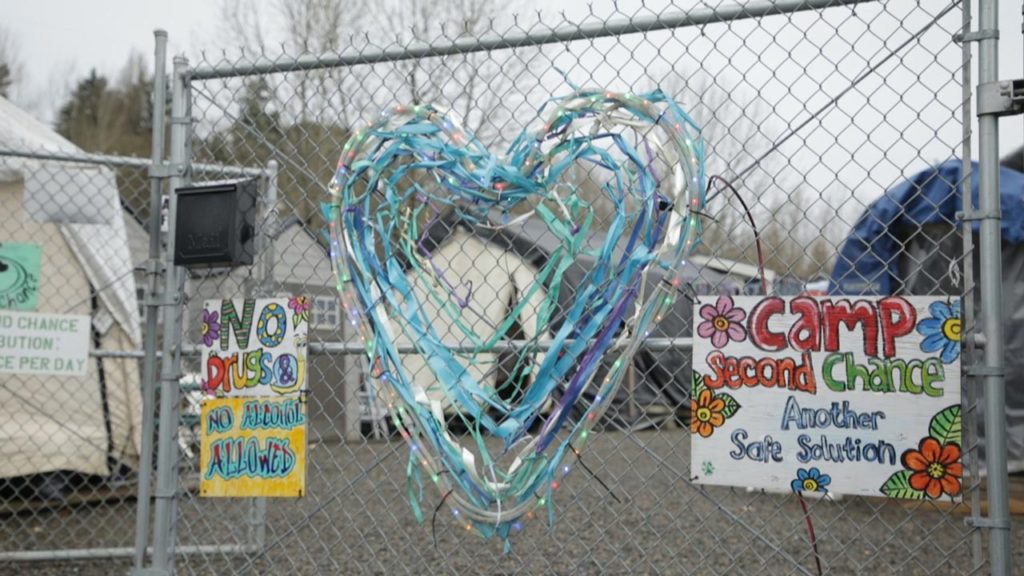Photo courtesy of SpIFF. Front gate of Camp Second Chance from the film “Stories of Us: Camp Second Chance.”
“Stories of Us: Camp Second Chance” and “The Hidden Homeless” were shown at The Magic Lantern Theatre as part of the Spokane International Film Festival a few weeks ago, both detailing the struggles of the homeless in the Pacific Northwest.
On March 4 at 7:30 p.m., as a dual showing, “Stories of Us: Camp Second Chance” and “The Hidden Homeless” premiered to Spokane audiences. The first film, “Stories of Us” details filmmaker Melinda Raebyne’s journey through documenting a homeless camp, Camp Second Chance, located in Seattle, and the residents of the camp. The film wastes no time in establishing how impactful the tone the rest of the movie is going to be. During an interview with a homeless man in the beginning of the film, Raebyne asks how it felt bouncing from place to place as a child, and a powerful silence envelopes the scene as the man thinks about his answer.
The film utilizes interviews to paint individual portraits of all of the campers and shows how each person ended up homeless. The reasons given range from mental illness and drug and alcohol abuse to job losses and rent hikes, which ended up being the most common.
“Stories of Us” goes into great detail about how Seattle’s homeless feel about the label homeless, as most don’t identify with being homeless until the label is placed on them by others, because of the stigma that being homeless carries with it. In fact, Raebyne explains how mental health issues among those who are technically homeless can arise from the label being placed on them. She describes her own internalized shame with being associated with the campers in public, “I had a shame around being identified as homeless.”
“Stories of Us” is technically impressive, with excellent lighting and beautifully composed shots of the camp and the surrounding Seattle winter wilderness. There are multiple excellent closeup scenery shots of the camp and the city with the score accompanying them. One shot in particular highlights the camp’s Christmas tree, with the camera unfocusing to create a beautiful shot with bokeh of the lights decorating the tree.
However, the film falls flat by not providing a direct call to action. Though she created a masterful film, Raebyne stated that she was “not here to solve homelessness.” Despite the end of the film showing the attempts to get Senate Bill 5946 (a bill that would have temporary shelters and encampments be exempt from “the state environmental policy act,” according to the proposed Senate Bill) and having a very clear political message, Raebyne’s film remained in a limbo of sorts. Personally, I would have liked to have seen Raebyne make a clear statement regarding solutions to homelessness, rather than remaining apolitical and not making a definitive statement in regards to a solution.
The same problem existed in “The Hidden Homeless,” as well, but to a more prominent extent. Being set in Spokane, “The Hidden Homeless” details the struggles of a specific subset of the homeless population within the Spokane community: families with children. Again, the film is well-crafted, composed and shot with a very clear documentary style. The opening scene of the film is a long drone shot flying over the Spokane River, eventually flying toward the director and narrator of the film, Maurice Smith, at the top of the Pavillion in Riverfront Park.
The main strengths of this film come from how it focuses on a demographic most Spokane residents wouldn’t think about when they think of the term “homeless,” as well as how Smith explains the methodology behind the statistics utilized in the film. The filmmakers did their own calculations regarding how many homeless people are in Spokane, independently of any studies previously conducted, as they are shown to be undercounting the homeless population significantly.
“The Hidden Homeless” showcases various families utilizing the resources Spokane provides for homeless families, specifically a center called Family Promise. The film showcases interviews with a single father and his daughter, who moved all the way from the U.S. South to Spokane, and in the beginning, a single mother, Kelly, and her son, Rigby, detail their experiences with the Spokane organization Family Promise, as well.
However, “The Hidden Homeless” feels far less genuine and more distant than “Stories of Us,” as the audience never sees Smith interact with any of the families, in stark contrast to the very in-depth reporting done by Raebyne. On its own, it would be a fine documentary, but after seeing “Stories of Us,” “The Hidden Homeless” felt very cold and less authentic. In addition to this, the film places the responsibility of ending homeless on the audience. Volunteering at local homeless shelters and donating money and time does help the individual homeless person, but to solve homelessness overall, more widespread action has to be done by local governments.
“The Hidden Homeless” appears to have been on YouTube at one point, but the link appears to be dead now, though, presumably, both films will be able to be found online after they have completed the film festival circuit.



